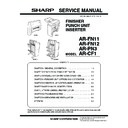Sharp AR-F12 (serv.man6) Service Manual ▷ View online
2-15
CHAPTER 2 FINISHER UNIT BASIC OPERATION
B.
Type of Delivery Paths
The finisher has three different paper paths for delivery, each selected to suit paper size and
delivery mode.
1.
Straight Path
When stacking copies shown in Table 2-201, the copies pass under the buffer roller.
Copy size
Length or width 182 mm or less
Typical copy examples
A5-R, ST-R, thick paper
Table 2-201
Delivery roller
Buffer roller
Figure 2-210
2.
Buffer Paper Path 1
When stacking copies shown in Table 2-202, the copies pass over the buffer roller, increasing the
distance between copies.
Copy size
Length and width 182 mm or more
Typical copy examples
A3, B4, A4, A4-R, B5, B5-R, LD, LG, LT, LT-R, (excluding
transparencies and thick stock)
Table 2-202
Buffer roller
Feed roller 2
Delivery roller
Figure 2-211
2-16
CHAPTER 2 FINISHER UNIT BASIC OPERATION
3.
Buffer Paper Path 2
This is the paper path when copy sizes shown in Table 2-203 are stacked. A maximum of three
copies (three originals or more in the staple mode) are wrapped round the buffer roller, during which
job offset and stapling are performed on the stapling tray.
job offset and stapling are performed on the stapling tray.
Copy size
Length 182 to 232mm, and width 182 to 297mm
Typical copy examples
A4, B5, LT, (excluding transparencies and thick stock)
Table 2-203
The following shows paper delivery operation in the case of three originals in the staple mode.
1) The first copy is moved in the direction of the buffer roller.
Buffer roller
First copy
Figure 2-212
2) The first copy wraps around the buffer roller and, at the same time, the second copy arrives from
the host machine.
First copy
Second copy
Figure 2-213
2-17
CHAPTER 2 FINISHER UNIT BASIC OPERATION
3) The second copy is laid over the first copy and, at the same time, the third copy arrives from the
host machine.
First copy Second copy
Third copy
Figure 2-214
4) The first, second and third copies are simultaneously pulled into the stapling tray.
Second copy
Third copy
First copy
Figure 2-215
Cauiton:
The third copy as explained here is moved through buffer paper path 1. This fact is omitted from
the discussion to avoid interrupting the sequence of operations.
the discussion to avoid interrupting the sequence of operations.
2-18
CHAPTER 2 FINISHER UNIT BASIC OPERATION
C.
Feeding and Delivering
1.
Outline
The finisher moves copies arriving from the host machine to the delivery tray, stapling tray, or the
saddle stitch unit (Saddle Finisher) according to the mode of delivery. On the stapling tray, the copies
are subjected to job offset or stapling as instructed by the host machine.
are subjected to job offset or stapling as instructed by the host machine.
The first feed motor (M1), second feed motor (M8) and inlet feed motor (M9) are stepping mo-
tors, and delivery motor (M2) is a DC motor. These motors are controlled by the microprocessor
(CPU) on the finisher controller PCB, and rotate either clockwise or counterclockwise.
(CPU) on the finisher controller PCB, and rotate either clockwise or counterclockwise.
The paper paths are equipped with the following four sensors for detection of paper (arrival,
passage):
●
Inlet sensor (PI1)
●
Delivery sensor (PI3)
●
Stapling tray sensor (PI4)
●
Buffer path paper sensor (PI14)
In addition, each delivery tray is equipped with a sensor designed to detect the presence/absence
of paper on it.
●
No.1 tray paper sensor (PI11)
●
No.2 tray paper sensor (PI12)
If a copy fails to reach or move past each sensor within a specific period of time, the finisher
controller PCB identifies the condition as a jam, and stops the ongoing operation, and at the same
time, informs the host machine of the condition. When all doors are closed after the paper jam is
removed, the buffer path inlet paper sensor (PI17) checks whether or not copies are being detected in
addition to the above four sensors (inlet sensor, delivery sensor, stapling tray sensor and buffer path
paper sensor). If the sensors detect a copy, the finisher unit judges that paper jams have not com-
pletely been removed, and sends the paper jam removal signal to the host machine again.
time, informs the host machine of the condition. When all doors are closed after the paper jam is
removed, the buffer path inlet paper sensor (PI17) checks whether or not copies are being detected in
addition to the above four sensors (inlet sensor, delivery sensor, stapling tray sensor and buffer path
paper sensor). If the sensors detect a copy, the finisher unit judges that paper jams have not com-
pletely been removed, and sends the paper jam removal signal to the host machine again.
Click on the first or last page to see other AR-F12 (serv.man6) service manuals if exist.

